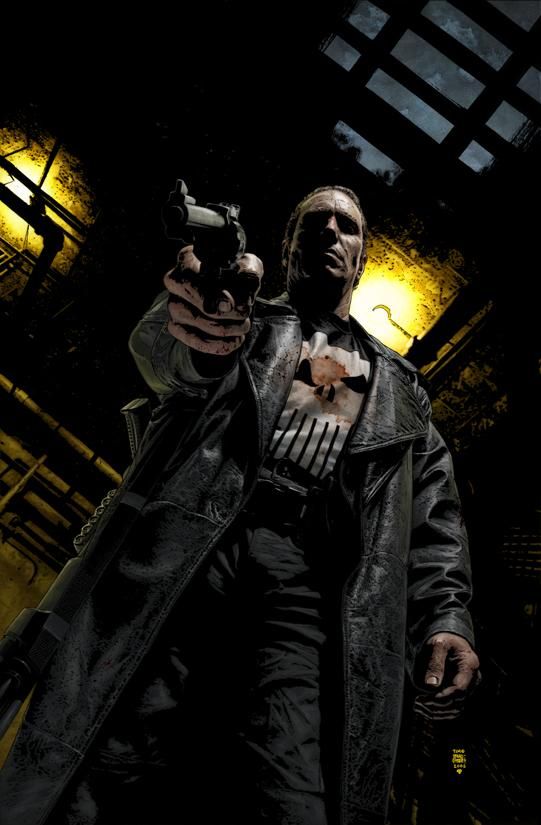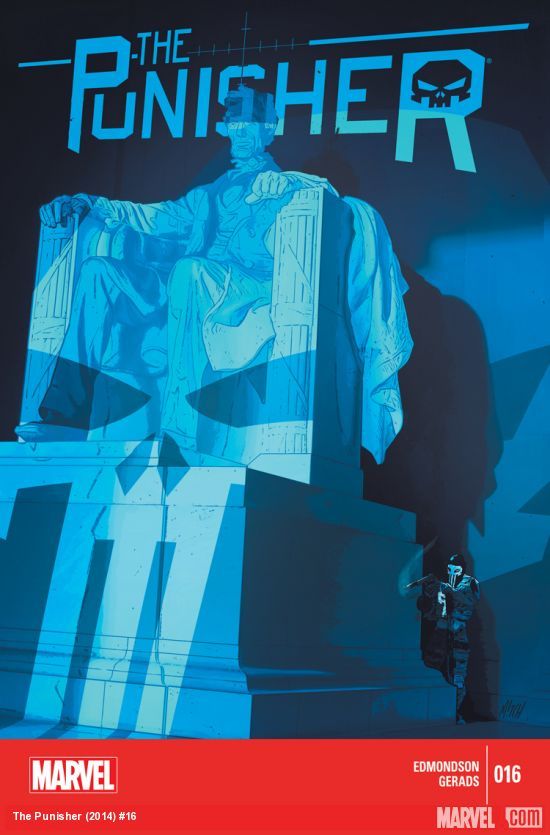I think I finally realized why we're here. The penultimate issue of Nathan Edmondson's run on The Punisher, Issue 17, arrived this week and contained more of a solid understanding of the Frank Castle than I felt the previous installments had. Don't get me wrong, Frank's adventures in Los Angeles fighting a South American drug cartel have been spectacular in design and action, but the purpose of the run hasn't come into focus until the Punisher was staring down Captain America in our nation's capital.
You see, the Punisher is kind of like a very fancy hat: It looks great with the right outfit and on the right occasion, but you simply can't wear it with everything you own.
You'd think the Punisher's purpose (revenge) being so simple would mean he translates well into whatever you want, and in a way he does. But a mortal man who kills criminals can get lost in the shuffle of outrageous superheroic events. Frank Castle doesn't fit well within the wider context of the Marvel Universe because so many other people do his job better in that they're in a better moral position. Spider-Man stops bank robbers by webbing them up for the police; the Punsher stops them with a bullet to the face. One of these gets to trump the other, and because Marvel tends to err on the more optimistic side of morality, Spider-Man wins this one.
In a way, placing Frank Castle within the larger context ruins his gimmick: The supervillainy of Doctor Doom can't be solved by shooting anything, so the Punisher looks weak. His lack of powers either makes him useless against superpowered people or turns into this outrageous comedy spot where the Punisher goes to Bugs Bunny-like lengths to win the day, pushing the situation into parody. The best setting for the Punisher is a much more intimate and with single, focused view. Seeing Punisher on the street dealing with more "realistic" scenarios makes it easier for readers to put themselves in his boots and understand his one-man fight against crime. Think of him like Batman: the same core motivation (driven to fight crime by the murder of his family), only with no need to explain why he dresses up like a bat.
Context can either sink the Punisher as concept or give him ample room to connect with the reader. Garth Ennis used the Punisher as a force of nature, death personified to a whole host of terrible people. His best stories dealt with the lengths people would go to stop, kill or escape from Frank Castle. The Punisher was more distant from the story being told and more of an end result. It was practically cathartic to see the Punisher blow up these vile criminals from Ennis' imagination and there was a kind of noble sense of purpose, despite the brutality of what the page depicted. Ennis is fond of the cowboy mystique, and the Punisher, for a time, became sort of an American legend of justice, the messy bits of both forgiven by an artful storyteller.
In comparison, Jason Aaron's run can be considered the visceral heart of the Punisher, motivation in motion. Every character was so emotionally tied to his purpose, it could hook the reader in and drag them through the broken glass of the story. It was just as brutal as Ennis' issues, if not more so because of how close we get to why the Punisher is out there to begin with. There's no idealism in Aaron's Punisher, because there's no room for that; it's all just base passion and need, ending in a very human way.
If Ennis tells us what the Punisher does and Aaron shows us why the Punisher does it, then Edmonson is here to explain where Frank Castle does his punishing. Venue is important, as the Punisher needs to fight crime at a level that can mean something without overreaching his goals. Why does the Punisher fight street-level mob forces when there are criminal networks that span the globe? Why doesn't his fight take him to city hall, so to speak, for a larger impact?
Moving the Punisher out of his element started Edmonson's run off on an awkward foot. It's kind of like seeing Spider-Man fight crime in Milwaukee: Some heroes are just naturally associated tied to their locations of choice, mostly New York City. As the drug cartel's reach got broader and more complicated, the more the Punisher seemed out of his depth. I'll admit it was kind of a turnoff to read at first because the footing of our hero seemed off-balance. More and more as the Punisher fought from a citywide crime war through an international cartel all the way to Washington, D.C., Frank Castle started to drown in the depths of the corruption he turned his sights toward.
In The Punisher #16, the top of the food chain, the corrupt Secretary of State himself, explains to why one man with a gun is laughably out of his league. It's sobering, both to the reader and to Castle himself, that no one person can take on City Hall and win, no matter how much we want to believe otherwise. By the time the Punisher is facing down Captain America, he's had time to set himself straight and return to the streets where he can make a difference. Corrupt politicians have to be left to the classic superheroes with loftier morals -- Captain America provides the best example -- while Frank remembers gets back to doing what he does best.
The man who played the Punisher in the oft-forgotten masterpiece Punisher: War Zone, Ray Stevensen, said it best when he explained that no one should want to be the Punisher, but everyone should be glad he's there.




